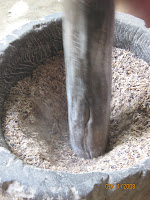INENI. Ineni
rice varieties have long stalks and take longer to grow before harvest. When it rains hard just before the harvest,
the rice plants may lie closer to the ground (mayjepes) and it makes it harder to harvest them. It is more backbreaking to harvest a nayjepes because one has to bend a
little to reach for them. Unlike when
they are standing straight, then it is more comfortable harvesting just
standing.
DAKEM. A small sickle used to harvest the ineni. The dakem cuts one or two rice stalks at a time. One can just imagine how long it takes to harvest a sankavaneng (one rice field) especially when it is nayjepes. It usually takes two to three days of aduyon to harvest about 20 kavaneng (20 rice fields). This might had been one of the reasons that Ibaloy farmers then had big families so that they have had a number of children to help in farm work.
TINAN-AY. A bundle of harvested rice or pagey (with its stalk) is called sahey tan-ay tied with the use of a banban (bamboo strip). The tinan-ay (bundles of rice) are then stored in a daktang (platform made of bamboo) built near the ricefields. When the tinan-ay are already dry enough (which also means lighter to carry), they are brought to a rice storage near one's house.
AKSIW/SAKWIL/SAKSIL. A neck yoke: a bamboo bar with its ends a
little pointed but blunt, used to carry the tinan-ay
from the field to the house (or watwat from the feast to households).
SAFATAN or ALANG. The tinan-ay are then brought to a safatan or an alang. Safatan is a storage above the shahidan (cooking area) where the rice is further dried as it gets heated every time somebody cooks. Alang or rice granary is a small hut or one-room house separate from the main house.
TALTAG
- When the family needs rice, they bring out some tinan-ay and pound it on a katat
(dried cow or carabao hide) or on the ground (concrete for some in the 80’s)
until the rice grains get separated from the stalks. This task is called the taltag.
TAAP
OR TAAPAN. To make sure that there is
just the rice grains (now called irik),
the others mixed with it are cast away using a kiyag/digao (winnower). The
waste also now called taep/taap and
the rice stalk now called arutang. The taap
and arutang are actually not waste
but are used for other purposes.
 |
| KU-DAS |
All of the above-mentioned tasks are done by the family members together. They pound rice together so one household has three to four da-do, otherwise, they borrow from their neighbors.
 |
| KUMPAY |
 |
| KAFAS |
May the Ibaloys continue to share such stories to their children and
grandchildren, not only to preserve the terms but more and hopefully so to make the children
appreciate the hard labor their parents and ancestors had gone through, to make
them appreciate the blessings they are receiving today as most of them no longer experience such labor in the farm, to have more reasons to
talk about and to each other, and to make them be prouder of their Ibaloy
heritage.

No comments:
Post a Comment